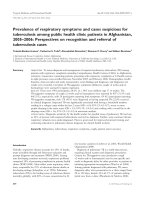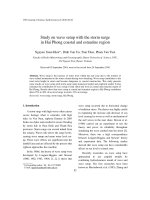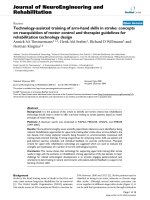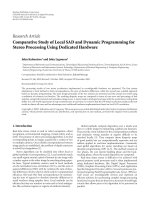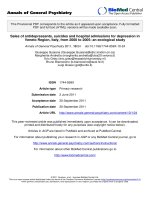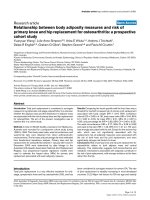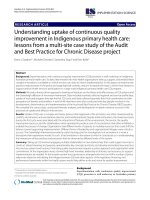Study on prevalance of drug resistance and genetic mutation for drug resistance HIV on HIV/AIDS patients with first line antiretroviral treatment failure at Dongda hospital Ha Noi
Bạn đang xem bản rút gọn của tài liệu. Xem và tải ngay bản đầy đủ của tài liệu tại đây (308.98 KB, 8 trang )
Journal of military pharmaco-medicine n08-2017
STUDY ON PREVALANCE OF DRUG RESISTANCE AND
GENETIC MUTATION FOR DRUG RESISTANCE HIV ON
HIV/AIDS PATIENTS WITH FIRST-LINE ANTIRETROVIRAL
TREATMENT FAILURE AT DONGDA HOSPITAL HA NOI
Pham Ba Hien*; Do Tuan Anh**; Tran Viet Tien**
SUMMARY
Objectives: To study prevalence of drug resistance and genotype testing for drug resistance
HIV on HIV/AIDS patients with first-line antiretroviral treatment failure at Dongda Hospital,
Hanoi. Subjects and methods: Cross-sectional, descriptive, prospective study on 47 HIV/AIDS
patients with first-line antiretroviral treatment failure at Dongda Hospital, Hanoi during period
from 6 - 2011 to 12 - 2016. Results: The prevalence of drug resistance HIV was 90.7%; 97.7%
resisted NNRTIs, following NRTIs: 95.3% and PIs group 11.6%. Among genetic mutations
resistance to NNRTIs: G190A mutation was the highest (51.2%); K103N mutation was 39.5%
and Y181C mutation was 34.9%. Genetic mutations in NRTIs: M184V mutation was 88.4%; in
TAM mutations, K70R mutation was the most common (37.2%); followed D67N, T215F, T69N
mutation was 27.9%; 27.9% and 25.6%, respectively. Genetic mutations in PIs: M36I and K20R
mutation made up 9.3%. In NNRTIs, the prevalence of NVP resistance was 95.3% and ETR
resitance was 4.7%. In NRTIs, lamivudine resistance was 93.0% and AZT resistance was 9.3%.
No LVP/r resistance was recorded. Conclusions: Patients with first-line antiretroviral treatment
failure had high prevalence of NNRTIs and NRTIs resistance but still susceptible to PIs.
* Keywords: HIV; Drug resistance; First-line antiretroviral treatment failure; Genetic mutation
for drug resistance.
INTRODUCTION
Thanks to antiretroviral (ARV) drugs
that inhibit the growth of HIV, patients
treated with ARV can live long and have
reasonably heathy lives. ARV therapy is
recommended due to the capacity assist
the immune function and reduces HIVrelated adverse outcomes. ARV therapy
widely used in patients with indication,
contributes to a new pathway in the prevention
and treatment of HIV/AIDS by reducing
the risk of HIV transmission in the population
and improving the quality of life of AIDS
patients. However, the emergence and
widesrpead of drug resistance HIV are
inevitable trend due to prolonged treatment.
Moreover, side effects of ARV are
sustainable factors leading to nonadherence to treatment, which contribute
to drug resistance HIV and uncontrolled
disease in community. The development
of drug-resistant virus strains predisposes
treatment failure and patients who had
treatment failure should be changed to
use higher-line ARV therapy (higher-level).
* Dongda Hospital
** 103 Military Hospital
Corresponding author: Pham Ba Hien ()
Date received: 20/08/2017
Date accepted: 21/09/2017
207
Journal of military pharmaco-medicine n08-2017
In Vietnam, drug-resistance HIV testings
are extravagant and are not performed regularly.
Therefore, to help clinicians optimize
the effectiveness of ARV treatment, we
performed this study with aims: To determine
the proportion of drug resistance and
genetic mutation for drug resistance in
patients with first-line ARV treatment failure.
SUBJECTS AND METHODS
1. Subjects.
47 HIV patients with fist-line ARV treatment
failure in HIV/AIDS outpatient clinic in
Dongda Hospital from June, 2011 to
December, 2016 were enrolled.
* Selected criteria:
- Age ≥ 18.
- Patients were diagnosed HIV positive
3 times, using 3 different commercial kits
with different principles and antigens [2].
- Patients were treated by first-line ARV
(zidovudine + lamivudine + nevirapine or
stavudine + lamivudine + nevirapine) and
diagnosed treatment failure according to
guidelines for diagnosis and treatment
HIV/AIDS issue in 2009 [2].
- Agree to participate in this study.
* Exclusion criteria:
- Do not come to the examination, test,
take medicine by appointment.
- No cooperation (compliance) in the
research process.
2. Methods.
Cross-sectional, descriptive, prospective
study.
* Nucleotid sequencing testing to indentify
the drug resistance mutations:
208
Conducted at Molecular Biology
Laboratory, National Institute of Hygiene
and Epidemiology. The study focused on
identifying antiretroviral resistance mutations,
Pol gene sequences (~ 1,800 bp) including
the entire Prot (protease) gene and at least
250 codons of the reverse transcriptase
(RT) gene; used Trugene® HIV-1
Genotyping Kit and OpenGene® DNA
sequencing system. Mutations are recorded
when nucleotide mutations occur
simultaneously on both downstream and
inverted pathways and lead to changes
in amino acids. Gene sequences were
collated with the Stanford University
Genomic Database (USA) using the
HIVdb (Stanford HIV Drug Resistance
Database) software. Show each amino
acid corresponding to each of Prot and
RT sites to detect resistance mutations and
estimate resistance levels (potent, low,
medium or high) for each drug in the three
groups NRTIs, NNRTIs, PIs. This drug
resistance compiler is based on the
International AIDS Society (USA Panel
Guidelines) 2010 [6].
SPSS 20.0 for Windows program was
used for statistical analysis.
RESULTS AND DISCUSSION
1. The propotion of patients having HIV
with genetic mutation for drug resistance.
Among the 47 patients enrolled,
43 patients had genetic mutation for drug
resistance (accounted for 90.7%). Tran Thi
Phuong Thuy’s research demonstrated
that 5% of patients with HIV-1 treatment
Journal of military pharmaco-medicine n08-2017
failure had not resistance mutation [1].
The proprotion of these patients was
2.8% in Nguyen Huu Chi’s study [3].
Thus, it can be seen that HIV in patients
with treatment failure do not mean that
they resist ARV drugs. There are many
factors that affect the viral replication,
which lead to treatment failure with HAART
including poor adherence to ARV therapy,
factors related to the pharmacokinetics of
drugs such as metabolism for example,
absortion, drug interactions; low baseline
TCD4 cell count and high pre-treatment
viral loads.... When drug resistance testing
are not used, doctor probably determines
to unnecessary conversion to second-line
regimens. Meanwhile, delaying the transition
to second-line regimens upon failure of
first-line regimen increases the occurrence
of new drug-resistant mutations.
Table 1: Variation in expression of ARV resistance mutation in patients with
treatment failure.
Drug resistance mutations
Quantity (n = 43)
Percentage %
NNRTI resistance mutations
42
97.7
NRTI resistance mutations
41
95.3
PI resistance mutations
5
11.6
NNRTI + NRTI resistance mutations. PI non-resistance mutations
35
81.4
NNRTI + NRTI + PI resistance mutations
5
11.6
NNRTI resistance mutations. NRTI and PI non-resistance mutations
2
4.7
NRTI resistance mutations. NNRTI and PI non-resistance mutations
1
2.3
Nguyen Huu Chi investigated drugs resistance mutation in 71 treatment failure
patients who had drug resistance mutation testing. Among them, the highest percentage
resistance was seen in NRTI, accounted for 97.2%, followed by NNRTI resistance with
87.3% and PI resistance with 5.6% [3]. According to Vietnamese researchers, the rates
of PIs resistance were low in our country due to the PI drugs are rarely used and
transmitted drug resistance HIV is also rare in Vietnam [3]. Adversely, NRTI resistance
was the most common as it is the first-choice drug.
2. Drug resistance mutations.
Table 2: The location of NNRTIs resistance mutations.
Location of
mutant gene
Quantity
The percentage in patiens
with drug resistance
mutation (n = 43)
The percentage in
patients with treatment
failure (n = 47)
1.
A98G
3
7.0
6.4
2.
M230L
1
2.3
2.1
3.
K101H
6
14.0
12.8
4.
K101E
10
23.3
21.3
5.
K101PQ
1
2.3
2.1
Number
209
Journal of military pharmaco-medicine n08-2017
6.
K101EQ
1
2.3
2.1
7.
K101HQ
1
2.3
2.1
8.
K103N
17
39.5
36.2
9.
G190S
1
2.3
2.1
10.
G190A
22
51.2
46.8
11.
Y181I
1
2.3
2.1
12.
Y181C
15
34.9
31.9
13.
Y181V
1
2.3
2.1
14.
Y188L
3
7.0
6.4
15.
V106I
3
7.0
6.4
16.
V108I
1
2.3
2.1
17.
V179T
3
7.0
6.4
18.
Y179D
1
2.3
2.1
19.
V179E
1
2.3
2.1
20.
P225H
2
4.7
4.3
G190A is a mutation selected by NVP and EFV. G190A is highly resistant to NVP
and has a moderate resistance to EFV as well as causing resistance in the NNRTI
group. This mutation has accumulated over long periods of treatment with all NNRTIs.
Most of the main resistance, Y181C, G190A, K103N, K101E, K101H were found. This is a
group with low genetic barriers. All mutations were associated with cross-resistance in
the NNRTI group. The occurrence of these mutations resulted in failure of the NNRTI
treatment regimen. Therefore, patients with NNRTI resistance mutations should avoid
using these agents in the alternative regimen.
Table 3: The location of NRTIs resistance mutation.
Quantity
The percentage in patiens
with drug resistance
mutation (n = 43)
The percentage in
patients with treatment
failure (n = 47)
D67N*
12
27.9
25.5
3.
D67N*
12
27.9
25.5
4.
V75M
16
37.2
34.0
5.
V75IM
1
2.3
2.1
6.
V106I
2
4.7
4.3
7.
V108I
5
11.6
10.6
8.
V118I
4
9.3
8.5
9.
K65R
5
11.6
10.6
10.
K70R*
16
37.2
34.0
Number
1.
Location of
mutant gene
2.
210
Journal of military pharmaco-medicine n08-2017
11.
K101Q
2
4.7
4.3
12.
K101H
2
4.7
4.3
13.
K210R
1
2.3
2.1
14.
K219E*
4
9.3
8.5
15.
K219E/Q*
2
4.7
4.3
16.
K219Q*
7
16.3
14.9
17.
T69D
2
4.7
4.3
18.
T69N*
11
25.6
23.4
19.
T215Y
2
4.7
4.3
20.
T215F*
12
27.9
25.5
21.
T215FS
1
2.3
2.1
22.
T215F/Y
1
2.3
2.1
23.
M41L*
6
14.0
12.8
24.
M184I/V
2
4.7
4.3
25.
M184V
38
88.4
80.9
26.
A62V
2
4.7
4.3
27.
A98G
1
2.3
2.1
28.
L74V
3
7.0
6.4
29.
L210W*
5
11.6
10.6
30.
F77L
2
4.7
4.3
31.
F116Y
2
4.7
4.3
32.
Q151M
3
7.0
6.4
33.
E44D
2
4.7
4.3
34.
H208Y
1
2.3
2.1
* TAM mutation:
The rate of M184V mutation was high, accounted for 88.4%. This may explain that
lamivudine which was a selected drug for this mutation is present in all first-line regimens.
Lamivudine is a widely used drug in Vietnam for the treatment of chronic hepatitis B,
which is a highly prevalent disease in the population. This drug is considered to have
poor resistance barrier and has a very high rate of drug resistance after initial treatment
in chronic hepatitis B [7]. In many studies and reports in Vietnam, the incidence
of TAM mutations has also been mentioned extensively: in Doan Thu Tra’s study,
TAM mutations including the K70R and K219E accounted for 20.25% and 13.95%,
respectively [5]. According to Huynh Hoang Khanh Thu’s research, the mutation at
the D67N site accounted for 37% and was higher than other mutations [4]. Tran Thi
Phuong Thuy had found that TAM mutation usually occurred at K65R site T215F,
K219 E/Q, K70R and 67.4% of patients had both M184V/I and TAM mutations [1].
211
Journal of military pharmaco-medicine n08-2017
Table 4: The location of PIs resistance mutation.
Number
Location of
mutant gene
Quantity
The percentage in drug
resistance mutation
patients (n = 43)
The percentage in treatment
failure patients (n = 47)
1.
L33F
1
2.3
2.1
2.
M36I
4
9.3
8.5
3.
K20R
4
9.3
8.5
4.
L10I
1
2.3
2.1
5.
A71V
1
2.3
2.1
In Vietnam, there was few reports on PIs resistance mutation. Studies had shown
that PIs resistance mutation has low rate. In Doan Thu Tra’s study on patients with L89M,
I13V mutation accounted for 6.3% and 5.1%, respectively; Huynh Hoang Khanh Thu
indicated that the two main mutants recorded were M46I (0.9%) and V82V (0.9%) [4, 5].
Low rates of PIs resistance were a favorable factor in treatment.
Figure 1: Degree of NNRTIs resistance.
NVP is a low genetic barrier drug, one mutation in the center of RT (Reverse
Transctiptase) activity will occur drug resistance. The occurrence of major mutations at
high frequency has resulted in the ineffectiveness of NVP (95.3% drug resistance).
EFV is substituted for NVP when the patient is allergic to NVP. Therefore, the rate of
EFV resistance was low with 55.8% due to less common. The level of resistance to
ETR was lower than that of other drugs in the group because ETR resistance mutations
occurred when at least 3 new mutations were accumulated.
212
Journal of military pharmaco-medicine n08-2017
Figure 2: Degree of NRTIs resistance.
The percentage of patients with 3TC resistance was high (93%). Although, there was
no case reported with a history using, the similar result was seen in FTC resistance
because FTC has similar mechanism to 3TC. In patients with combination regimens of
d4T or AZT, TAM mutations and secondary mutations occurred, which resulted in multiple
drug resistance (41.9% D4T resistance; 9.3% AZT resistance). The rate of patients with
TDF resistance was 25.6%.
Table 5: The degree of PIs resistance (n = 43).
Degree of resistance
Resistance
Ability
Non-resistance
Drug
n
%
n
%
n
%
ATV/r
0
0
0
0
43
100
DRV/r
0
0
0
0
43
100
FPV/r
0
0
0
0
43
100
IDV/r
0
0
0
0
43
100
LPV/r
0
0
0
0
43
100
NFV
0
0
0
0
43
100
SQV/r
0
0
2
4.7
41
95.3
TPV/r
0
0
0
0
43
100
Among 5 patients with resistant mutation genes to the PI group, however, only two
cases were ability to be resistant to SQV/r. There were no cases of resistance to
other PIs, especially no resistant to LPV/r and ATV/r which were being introduced in
second line ARV regimen in Vietnam.
213
Journal of military pharmaco-medicine n08-2017
CONCLUSION
In 47 patients with first-line ARV therapy
failure, 90.7% had HIV with drug resistance
genes. Among them, the highest resistance
rate was seen in NNRTI group with 97.7%,
followed by NRTIs (95.3%) and PIs (11.6%).
In location of NNRTIs resistance mutation,
G190A had the highest rate with 51.2%,
followed by K103N, Y181C with 39.5%
and 34.9%, respectively. In the NRTIresistant mutant genotypes, the highest
percentage was seen in M184V accounted
for 88.4%; in TAM mutations, K70R mutation
was the most common 37.2%, followed by
D67N, T215F, T69N with 27.9%; 27.9%
and 25.6%, respectively. In the location of
PIs resistance mutation, M36I and K20R
accounted for 9.3%. In the NNRTI group,
NVP had the highest resistance rate of
95.3%. The lowest was the 4.7% ETR.
In NRTIs, lamivudine had the highest
resistance rate (93.0%) and the lowest
rate was seen in AZT with 9.3%. In PIs,
no LVP/r resistance was recorded but
might be resistant to SQV/r.
214
REFERENCES
1. Tran Thi Phuong Thuy. Study on antiretroviral
resistance in HIV/AIDS patients treated at the
Central Hospital for Tropical Diseases. Doctor
of Medicine Thesis. Institute for Clinical Pharmacomedical Science Research 108. 2012.
2. Viet Nam Ministry of Health. Guidelines
for Diagnosis and Treatment of HIV/AIDS.
Hanoi Medical Publishing House. 2009.
3. Nguyen Huu Chi, Nguyen Tran Chinh,
Vo Minh Quang. ARV resistance characteristics
in AIDS patients failing treatment with HAART
at the Tropical Hospital. City Medicine Hochiminh.
2008, Vol 12.
4. Huynh Hoang Khanh Thu. Understanding
the antiretroviral resistance (ARV) of HIV in
HIV-infected patients. Master Thesis in Genetics.
University of Natural Sciences, Vietnam
National University Hochiminh City. 2010.
5. Doan Thu Tra. Determination of drug
resistance of HIV in patients with first-line
therapy failure and evaluation of the efficacy
of second-line antiretroviral therapy in HIVinfected patients. Doctor of Medicine Thesis.
Institute for Clinical Pharmaco-medical Science
Research 108. 2016.
6. Johnson V.A, Brun-Vezinet F, Clotet B
et al. Update of the drug resistance mutations
in HIV-1: December 2010. Top HIV Med.
2010, 18 (5), pp.156-63.
7. Lok A.S, McMahon B.J. Chronic hepatitis
B: update 2009. Hepatology. 2009, 50 (3),
pp.661- 662.
